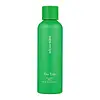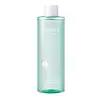What's inside
What's inside
 Key Ingredients
Key Ingredients

 Benefits
Benefits

 Concerns
Concerns

 Ingredients Side-by-side
Ingredients Side-by-side

Portulaca Oleracea Extract
Skin ConditioningPEG-60 Hydrogenated Castor Oil
EmulsifyingEucalyptus Globulus Leaf Oil
PerfumingCentella Asiatica Extract
CleansingDisodium EDTA
Propanediol
SolventAlcohol Denat.
AntimicrobialWater
Skin ConditioningMelaleuca Alternifolia Leaf Water
AntimicrobialSodium Hyaluronate
HumectantAmmonium Acryloyldimethyltaurate/Vp Copolymer
Eucalyptus Globulus Leaf Extract
PerfumingBetaine
Humectant1,2-Hexanediol
Skin ConditioningGlycerin
HumectantButylene Glycol
HumectantGlycereth-26
HumectantMelaleuca Alternifolia Leaf Oil
AntioxidantCamellia Sinensis Leaf Extract
AntimicrobialKjellmaniella Gyrata Extract
Skin ConditioningEthylhexylglycerin
Skin ConditioningPortulaca Oleracea Extract, PEG-60 Hydrogenated Castor Oil, Eucalyptus Globulus Leaf Oil, Centella Asiatica Extract, Disodium EDTA, Propanediol, Alcohol Denat., Water, Melaleuca Alternifolia Leaf Water, Sodium Hyaluronate, Ammonium Acryloyldimethyltaurate/Vp Copolymer, Eucalyptus Globulus Leaf Extract, Betaine, 1,2-Hexanediol, Glycerin, Butylene Glycol, Glycereth-26, Melaleuca Alternifolia Leaf Oil, Camellia Sinensis Leaf Extract, Kjellmaniella Gyrata Extract, Ethylhexylglycerin
Water
Skin ConditioningGlycerin
HumectantIsopentyldiol
HumectantHydroxyacetophenone
AntioxidantButylene Glycol
HumectantC12-14 Pareth-12
EmulsifyingOctyldodeceth-16
EmulsifyingSodium Citrate
BufferingEthylhexylglycerin
Skin ConditioningMelaleuca Alternifolia Leaf Extract
PerfumingCentella Asiatica Extract
CleansingCitric Acid
BufferingDisodium EDTA
Melaleuca Alternifolia Leaf Oil
AntioxidantPortulaca Oleracea Extract
Skin ConditioningVitex Agnus Castus Extract
AstringentChamomilla Recutita Flower Extract
MaskingCamellia Sinensis Leaf Extract
Antimicrobial1,2-Hexanediol
Skin ConditioningArctium Lappa Root Extract
Skin ConditioningPhellinus Linteus Extract
Skin ConditioningChamaecyparis Obtusa Water
MaskingSqualane
EmollientChamaecyparis Obtusa Leaf Extract
Skin ConditioningTocopherol
AntioxidantCetyl Ethylhexanoate
EmollientNeopentyl Glycol Diheptanoate
EmollientHydrogenated Phosphatidylcholine
EmulsifyingPolyglyceryl-10 Myristate
Skin ConditioningPolyglyceryl-2 Stearate
EmulsifyingStearic Acid
CleansingCetearyl Alcohol
EmollientCarthamus Tinctorius Seed Oil
MaskingOenothera Biennis Oil
EmollientPolyquaternium-51
Skin ConditioningCeramide NP
Skin ConditioningGluconolactone
Skin ConditioningMadecassoside
AntioxidantWater, Glycerin, Isopentyldiol, Hydroxyacetophenone, Butylene Glycol, C12-14 Pareth-12, Octyldodeceth-16, Sodium Citrate, Ethylhexylglycerin, Melaleuca Alternifolia Leaf Extract, Centella Asiatica Extract, Citric Acid, Disodium EDTA, Melaleuca Alternifolia Leaf Oil, Portulaca Oleracea Extract, Vitex Agnus Castus Extract, Chamomilla Recutita Flower Extract, Camellia Sinensis Leaf Extract, 1,2-Hexanediol, Arctium Lappa Root Extract, Phellinus Linteus Extract, Chamaecyparis Obtusa Water, Squalane, Chamaecyparis Obtusa Leaf Extract, Tocopherol, Cetyl Ethylhexanoate, Neopentyl Glycol Diheptanoate, Hydrogenated Phosphatidylcholine, Polyglyceryl-10 Myristate, Polyglyceryl-2 Stearate, Stearic Acid, Cetearyl Alcohol, Carthamus Tinctorius Seed Oil, Oenothera Biennis Oil, Polyquaternium-51, Ceramide NP, Gluconolactone, Madecassoside
Ingredients Explained
These ingredients are found in both products.
Ingredients higher up in an ingredient list are typically present in a larger amount.
1,2-Hexanediol is a synthetic liquid and another multi-functional powerhouse.
It is a:
- Humectant, drawing moisture into the skin
- Emollient, helping to soften skin
- Solvent, dispersing and stabilizing formulas
- Preservative booster, enhancing the antimicrobial activity of other preservatives
Butylene Glycol (or BG) is used within cosmetic products for a few different reasons:
Overall, Butylene Glycol is a safe and well-rounded ingredient that works well with other ingredients.
Though this ingredient works well with most skin types, some people with sensitive skin may experience a reaction such as allergic rashes, closed comedones, or itchiness.
Learn more about Butylene GlycolCamellia Sinensis Leaf Extract is derived from the leaves of the tea plant. Black tea, green tea, and oolong tea are all harvested from this plant.
This ingredient has many skin benefits:
This ingredient contains polyphenols, a strong antioxidant. Antioxidants help fight off molecules that damage skin cells.
On top of that, the antioxidants in green tea neutralize free-radicals from the sun. This gives the skin some extra UV protection, but should not replace sunscreen.
Many components of tea have anti-inflammatory properties.
Polyphenols and L-theanine help soothe the skin and reduce irritation. The caffeine in Camellia Sinensis Leaf Extract helps calm inflamed blood vessels.
Other compounds found in tea include: Vitamin Bs, linoleic acid, magnesium, calcium, iron, and zinc.
Research has shown both drinking Camellia Sinensis Leaf Tea and applying it to the skin can help boost skin elasticity and hydration. Studies also show using tea extract may reduce sebum, or oil, production.
Learn more about Camellia Sinensis Leaf ExtractCentella Asiatica Extract (Centella) is derived from an herb native to Southeast Asia. It is famous for its anti-inflammatory and soothing properties.
Centella is rich in antioxidants and amino acids, such as Madecassic Acid and Asiaticoside.
Studies show the compounds in centella help with:
The combination of all these properties makes centella effective at soothing, hydrating, and protecting the skin.
Other great components of centella include Vitamin A, vitamin C, several B vitamins, and Asiatic Acid.
Fun fact: Centella has been used as a medicine and in food for many centuries. As a medicine, it is used to treat burns, scratches, and wounds.
Learn more about Centella Asiatica ExtractDisodium EDTA plays a role in making products more stable by aiding other preservatives.
It is a chelating agent, meaning it neutralizes metal ions that may be found in a product.
Disodium EDTA is a salt of edetic acid and is found to be safe in cosmetic ingredients.
Learn more about Disodium EDTAEthylhexylglycerin (we can't pronounce this either) is commonly used as a preservative and skin softener. It is derived from glyceryl.
You might see Ethylhexylglycerin often paired with other preservatives such as phenoxyethanol. Ethylhexylglycerin has been found to increase the effectiveness of these other preservatives.
Glycerin is already naturally found in your skin. It helps moisturize and protect your skin.
A study from 2016 found glycerin to be more effective as a humectant than AHAs and hyaluronic acid.
As a humectant, it helps the skin stay hydrated by pulling moisture to your skin. The low molecular weight of glycerin allows it to pull moisture into the deeper layers of your skin.
Hydrated skin improves your skin barrier; Your skin barrier helps protect against irritants and bacteria.
Glycerin has also been found to have antimicrobial and antiviral properties. Due to these properties, glycerin is often used in wound and burn treatments.
In cosmetics, glycerin is usually derived from plants such as soybean or palm. However, it can also be sourced from animals, such as tallow or animal fat.
This ingredient is organic, colorless, odorless, and non-toxic.
Glycerin is the name for this ingredient in American English. British English uses Glycerol/Glycerine.
Learn more about GlycerinThis tea tree oil comes from the leaves of the Tea Tree plant. Tea tree oil has antioxidant, anti-inflammatory, and antimicrobial properties.
According to the book Journal of Profiles of Drug Substances, tea tree helps in reducing acne-causing bacteria such as Propionibacterium acnes. This is due to the Terpinen components of tea tree oil.
Tea tree may cause sensitivity and irritation for some people. This oil naturally contains fragrance such as linalool and limonene.
However, research shows irritation usually occurs when using pure tea tree oil and not in cosmetic products.
Tea tree oil was found to help relieve the symptoms of psoriasis in one study.
Tea tree oil is toxic when ingested. Another study showed it to caused damage to the nervous system of dogs and cats when applied to their skin or given orally.
Learn more about Melaleuca Alternifolia Leaf OilThis extract comes from Purslane, a succulent. It has anti-inflammatory, antioxidant, and hydrating properties.
Purslane is very nutritious. It contains omega-3 fatty acids, NMFs, many vitamins, minerals, and antioxidants. The vitamins found in purslane include: Vitamin C, Vitamin A, and Vitamin E.
Fun fact: Purslane is a succulent with an extensive habitat. It is used in traditional Korean medicine to treat irritated skin.
Nowadays, purslane is becoming a superfood due to its highly nutritious content.
Learn more about Portulaca Oleracea ExtractWater. It's the most common cosmetic ingredient of all. You'll usually see it at the top of ingredient lists, meaning that it makes up the largest part of the product.
So why is it so popular? Water most often acts as a solvent - this means that it helps dissolve other ingredients into the formulation.
You'll also recognize water as that liquid we all need to stay alive. If you see this, drink a glass of water. Stay hydrated!
Learn more about Water